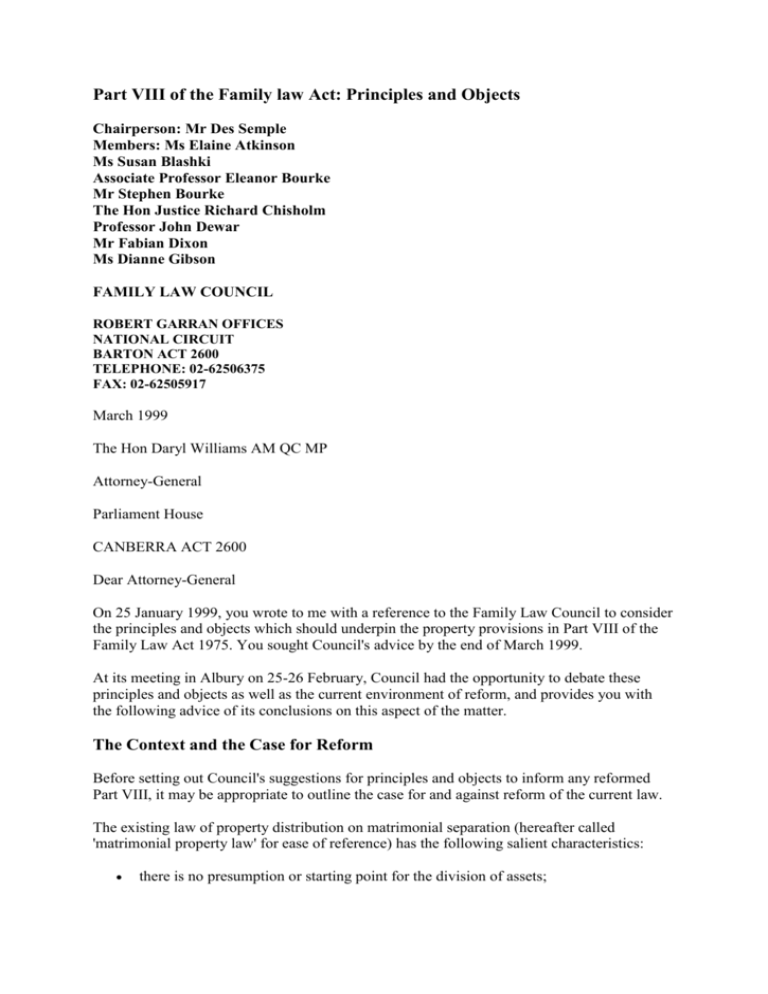Part VIII of the Family law Act: Principles and Objects
advertisement

Part VIII of the Family law Act: Principles and Objects Chairperson: Mr Des Semple Members: Ms Elaine Atkinson Ms Susan Blashki Associate Professor Eleanor Bourke Mr Stephen Bourke The Hon Justice Richard Chisholm Professor John Dewar Mr Fabian Dixon Ms Dianne Gibson FAMILY LAW COUNCIL ROBERT GARRAN OFFICES NATIONAL CIRCUIT BARTON ACT 2600 TELEPHONE: 02-62506375 FAX: 02-62505917 March 1999 The Hon Daryl Williams AM QC MP Attorney-General Parliament House CANBERRA ACT 2600 Dear Attorney-General On 25 January 1999, you wrote to me with a reference to the Family Law Council to consider the principles and objects which should underpin the property provisions in Part VIII of the Family Law Act 1975. You sought Council's advice by the end of March 1999. At its meeting in Albury on 25-26 February, Council had the opportunity to debate these principles and objects as well as the current environment of reform, and provides you with the following advice of its conclusions on this aspect of the matter. The Context and the Case for Reform Before setting out Council's suggestions for principles and objects to inform any reformed Part VIII, it may be appropriate to outline the case for and against reform of the current law. The existing law of property distribution on matrimonial separation (hereafter called 'matrimonial property law' for ease of reference) has the following salient characteristics: there is no presumption or starting point for the division of assets; assets are divided on the basis of the parties' contributions, both financial and nonfinancial, and on an assessment of their future needs, while spousal maintenance is reserved strictly for cases of proven need for continuing income maintenance where the other party has the proven capacity to contribute; and all property beneficially owned by the parties is potentially available for distribution (although complex jurisprudence has developed in respect of assets acquired by a party before a marriage, or business assets built up by one party during a marriage). Against this background, a number of arguments could be advanced for a change in the law: A concern on the part of government, and others, that the current law requires the court to exercise too much discretion, thereby creating uncertainty and making disputes harder to settle. This acquires a new urgency given the current policy of promoting Primary Dispute Resolution as much as possible. Firmer rules, it is thought, will make out of court settlement easier by providing the basis of clearer advice to parties. The provisions of Part VIII are primarily directed to the adjudication of disputes. It may be necessary to make more detailed and explicit rules for the vast majority of cases that do not require adjudication, but are resolved by agreement between the parties. A concern that the current law is not seen to be based on any clear principle (beyond recognition of past contributions and future needs, which are not themselves expressive of any wider principle or related to any particular conception of marriage). This lack of clear principle may promote a sense of grievance or unfairness amongst sections of the divorcing population, as well as exacerbate the uncertainties in the law already referred to. Legal aid is rarely available in property proceedings. This means that many separating or divorcing couples now have no or very little legal assistance in settling property matters on separation or divorce. To this group, the current law may seem very confusing, and may encourage some (especially the economically weaker party) to abandon legitimate claims. Related to the above is the argument that providing clearer rules may help to reduce the risk of one party conceding property in return for retention of residence of children or out of a fear of violence. This has sometimes been raised as a concern, especially in relation to the shift towards private ordering of family disputes. Providing a clearer and more readily understood framework of entitlements may encourage weaker parties not to abandon legitimate claims. Research evidence shows that despite the impact of the child support legislation, and despite the increased emphasis given by the Court to the section 75(2) factors in recent years, many women still experience long term hardship after separation. The chief reason for this is that, for most couples, it is earning capacity that is the parties' most valuable economic resource. In most families there is insufficient property to offset the imbalance by transferring assets. Spousal maintenance orders do not seem to have been used in a way that alters the position that in general women are economically disadvantaged after marriage breakdown in comparison to men. Arguably some change in the law will be necessary if the economic imbalance is to be redressed. At the same time there are arguments for retaining the status quo. These include: There is no evidence that the current system does make cases harder to settle. Family Court statistics show that 95% of cases settle before trial. Indeed, it could be argued that the current system makes it easier for lawyers to persuade their clients to settle, because of the unpredictability of a litigated outcome. Besides which, the current system is not as discretionary, nor as unpredictable, as some suggest. Instead, the Family Court has steadily developed its jurisprudence in such a way that the likely outcome, or settlement range, is easily predicted in most cases. In this context, it is important to acknowledge that some people will never agree to a property settlement regardless of the system in place; and that there are some cases that are so complex that they cannot be settled without judicial intervention. Any uncertainties in the current system are not necessarily a product of rule uncertainty, but of the inevitable difficulties associated with ascertaining the facts in each case and the differences from family to family in each relevant set of facts. The current law is flexible enough to allow the Family Court to evolve its jurisprudence in response to research findings and international trends. Thus, decisions such as Clauson, Mitchell, Kennon and others have subtly altered the landscape of Australian law to address, so far as possible, the known effects of divorce on primary carers, and the effects of violence; and, where there are relevant children, that the Child Support scheme has to some extent redressed inequities in the post-divorce income position of the parties. A shift towards continuing income transfers is to be avoided, even if they were conceptualised as equity adjustments for marriage-related income disparities. There is considerable support, especially among practitioners, for the clean break and any attempt to change that culture would likely meet with resistance. There are limits to what can be achieved through family law alone, and that many of the post-separation disparities of income and living standards are structural and can only be properly addressed through the welfare system and the labour market. The cost of change should be acknowledged. There will be an initial cost in financial, emotional and political terms in making reforms. For example, there will be confusion to the public and the profession for a time, and there will be a need for public education, test cases, and appeals. With these considerations in mind, we turn now to consider the principles and objects that, in our view, should inform a reformed Part VIII. Principles and objects of Part VIII Council suggests that the following general principles will be helpful in assessing any proposed revisions to Part VIII. The first two require most discussion, the remainder being relatively straightforward. Testing proposed revisions against these principles necessarily involves value judgments and matters of degree. Some of the principles involve matters on which compromise is necessary. However Council considers that testing proposed laws against these principles would provide a disciplined form of review that might help to identify the strengths and weaknesses of particular proposals. Principle 1: Equal status of husband and wife In Mallet, Gibbs CJ said that a principle implicit in many of the sections contained in Part VIII is "that the parties to a marriage are equal in status". This is the first general principle that we propose. It embodies a sentiment which is important and which seems likely to command widespread community support. This principle should not be confused with the proposition that the division of property should necessarily be equal, or indeed any other particular rule for division of property. In many cases, for example in long marriages where there are children and where the parties have commenced with roughly equal resources, there is evidence that many people are attracted to a notion of equal sharing of property (as in the sense of a 50/50 split) as an intuitively fair result, conforming with people's notions of justice and based on a belief that most couples contribute equally but differently to a relationship. The question whether the law should provide for equal sharing is in fact difficult. Questions arise, for example, about whether the equal sharing should apply to all property or only, for example, property acquired during the marriage. And where the division of responsibilities within the marriage has involved one partner in developing a career in paid employment, and the other concentrating wholly or partly on caring for children and the home, an equal division of property may well not be a just outcome, because it would produce unequal consequences for which there is no proper justification. Thus a rule of equal sharing may produce equality in one sense: each party receives the same share of the property. But it may produce inequality in another sense: one party may have economic advantages as a result of the division of responsibilities during the relationship. Nevertheless, despite its indeterminacy, this principle may be useful. While there may well be room for difference of opinion about whether particular rules do or do not comply with it, Council's view is that it is appropriate to consider whether any proposed rules do or do not conform with the principle. Rules which lead in practice to results which favour either husbands or wives would need to be scrutinised to see if they violate this principle. Principle 2: The law should conform with values accepted in the community Like the first principle, this principle does not lead self-evidently to particular results. Indeed, it might well be questioned whether, in a pluralistic community such as exists in Australia, it is possible to identify any ideas of fairness that are accepted in the community. It is obvious that people would not necessarily agree on the fairest outcome for financial adjustment in particular cases, or on which rules would be most appropriate. In Council's view, however, it would be wrong to assume that there are no commonly held views on these matters. There is some research evidence on people's views about what outcomes are fair in family property division. Those views are not randomly spread. It is possible to say that certain propositions or approaches are seen as fairer, or more just, than others. This principle means that in considering the merits of any existing or proposed law, it is desirable to assess, as best one can, the extent to which it conforms with people's views about what is fair. In general, such conformity, if it can be identified, is desirable. It does not follow that rules which do not have a high level of community support should necessarily be rejected. The area is complex and people's intuitive views on whether particular rules are fair may reflect a limited understanding of the issues, or more simply that they have not thought about the problem. For example, a person might instinctively consider an 80:20 division of property to be unfair, but might reconsider that reaction if it is pointed out, for example, that the assets amount to $30,000, and one partner earns $250,000 per annum and the other is dependent on social security. Council does not underestimate the difficulty of applying this principle. There may well be some issues on which there is no available evidence on what people consider fair, and others on which it can be shown that there is little agreement. Nevertheless, Council considers that it is useful to apply this principle, as best one can, in assessing the merits of particular rules and principles. Council has not had the opportunity to formulate what principles would have significant community support. It would be easy, but perhaps unhelpful, to state principles in such general terms as, for example, that the law should be "fair" or "just and equitable". However, it might be possible to identify principles that are a little more concrete. By way of example, there may be significant support for such principles as the following:Spousal autonomy The law should respect decisions by spouses themselves as to how their financial affairs should be regulated in the event of marriage breakdown, subject to safeguards intended to ensure that such decisions are fully informed and freely given, that their consequences have not been rendered unjust because of dramatically changing circumstances, and that it would not be contrary to public policy to enforce the agreement. An example of a case where a great deal of weight should perhaps be attached to the parties' agreement might be one where the parties were married in a country whose laws encouraged financial agreements upon marriage; each was marrying for a second time; they were of mature years and each financially independent; they had appropriate legal advice at the time; and that their situations were little different when they separated, having migrated to Australia. Examples of cases where little or no weight should perhaps be give to the agreement might be cases where the agreement was made without legal advice or under a threat of violence; where it was made when the parties were young and where the consequences of the marriage were very different from what they might reasonably have expected; or where the agreement would leave one party with substantial assets and income and the other dependent on social security. Economic consequences of division of responsibilities Property adjustment should take into account, among other things, the economic consequences for the parties of the division of functions during the marriage. This principle has its most obvious application to cases where one party has developed a career in the work force and the other has lost career skills, contacts and professional qualifications by caring for the home and children. Not compensating for all inequalities Property adjustment should not be expected necessarily to produce an equal standard of living for the parties, particularly where their inequalities are not related to the circumstances of the marriage but, for example, to inequalities in society or differences in abilities between the spouses. An example of this might be a case of a very short and childless marriage between a wealthy and highly skilled professional and a person with few qualifications: there might be general agreement that whatever re-adjustment should be made, it should not necessarily be such as to ensure that each party had an equal standard of living for the rest of their lives. Priority to the welfare of dependant children Property adjustment should take account of the best interests of dependant children. This might imply a principle that orders for property adjustment should, so far as possible, be framed to minimise the disruptive impact of parental separation on children, for example, by seeking to avoid an immediate sale of the family home. Principle 3: Clarity The law and the principles on which it is based should be as clearly stated as possible, so that they can be understood not only by legal practitioners but by litigants and members of the public. Principle 4: Certainty It is desirable that as far as possible the application of the law to particular cases should yield predictable results. From this point of view, systems that involve a high degree of judicial discretion may provide less certainty of outcome than those that involve the application of a definite rule. It does not follow that reducing judicial discretion is the only or even the main measure that would promote certainty. Predictability of results depends on a number of matters. In particular, outcomes may be hard to predict because of uncertainties of a factual kind, such as the existence or value of particular assets. Further, outcomes may be hard to predict where a rule, although not providing for judicial discretion, is uncertain in its application. For example, systems that distinguish between "matrimonial property" and "separate property" may lead to highly complex and uncertain disputes about whether particular assets or interests fall in one category or another. In Council's view, therefore, it is important to stress that what is desirable is certainty of outcome. Specificity of rules may or may not lead to certainty of outcome, depending on a variety of matters. Principle 5: Adaptability The law should recognise and accommodate diversity and be capable of applying to all kinds of marriages, including marriages of long or short duration, marriages with or without children, and marriages with substantial or few assets. Principle 6: Promoting settlement The law should provide guidelines and procedures to help spouses to resolve property matters informally, without oppressive bargaining and wherever possible, without resort to litigation. Principle 7: Timely and just adjudication The law should provide mechanisms for timely and just adjudication of those matters than cannot be settled. All people, not only those with wealth or legal representation, should be able to have access to such adjudication. Principle 8: Harmony with other laws The law of matrimonial property should not be in conflict with other areas of the law. Council looks forward to the release of the Government's discussion paper on property in the near future and anticipates making a further contribution to the debate in its response to the Government's paper. Yours sincerely Des Semple Chairperson







